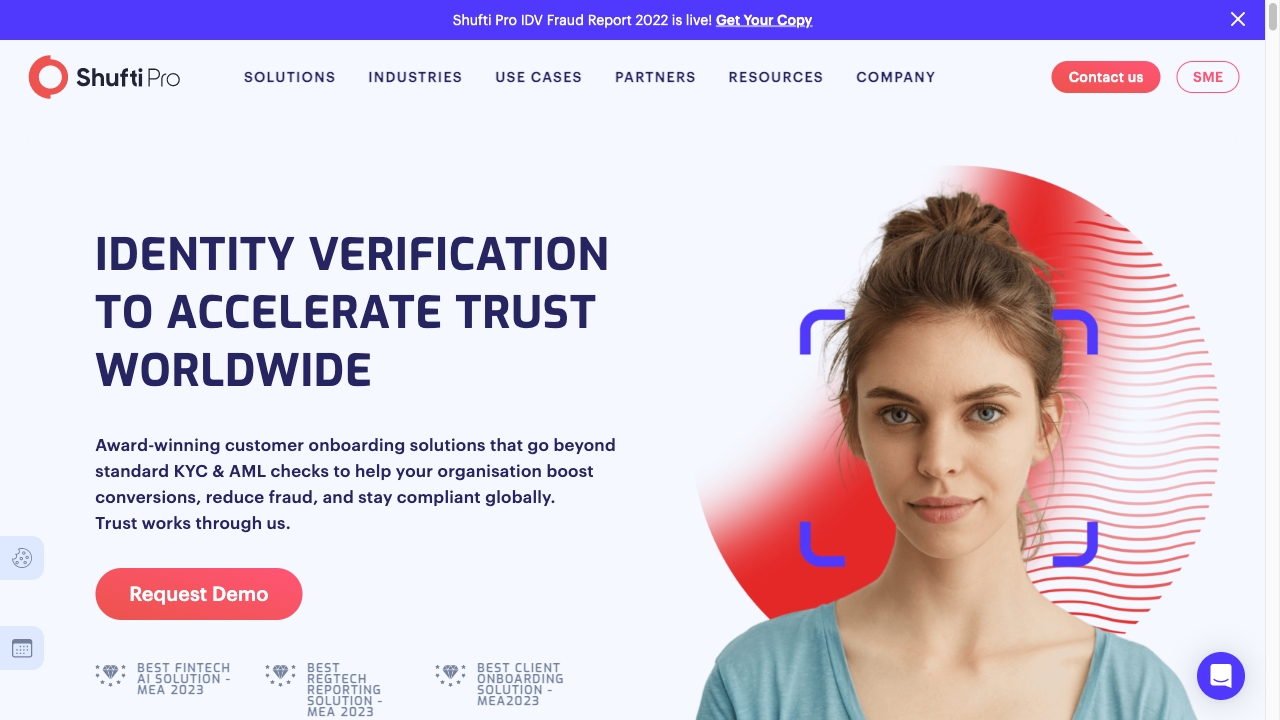- Home
- AI Face Recognition
- Shufti

Shufti
Open Website-
Tool Introduction:Real-time global ID checks beyond KYC/AML to cut fraud and drop-offs.
-
Inclusion Date:Oct 28, 2025
-
Social Media & Email:
Tool Information
What is Shufti AI
Shufti AI is an award-winning global identity verification platform designed to help organizations onboard users faster, cut fraud, and maintain KYC/AML compliance at scale. It goes beyond standard checks by combining real-time document authentication, biometric liveness, and sanctions/PEP screening into configurable workflows that minimize customer drop-offs. With an API-first approach, cross-border coverage, and analytics for audit-ready reporting, Shufti AI enables secure, conversion-friendly verification across diverse industries and regions.
Shufti AI Main Features
- Global KYC/AML screening: Screen users against sanctions, PEP, and adverse media lists to meet anti-money laundering and counter-terrorist financing obligations.
- Document verification: Validate passports, national IDs, and driver’s licenses with OCR and forgery checks to detect tampering and impurities.
- Biometric verification & liveness: Match selfies to ID photos and detect presentation attacks to confirm the user is real and present.
- Proof of address and age checks: Verify residency and age for regulated onboarding, gaming, and age-restricted services.
- Workflow orchestration: Configure step-up checks, decision rules, and fallback paths to balance risk and user experience.
- Real-time risk signals: Combine verification outcomes and contextual risk indicators to reduce fraud while keeping friction low.
- API, SDKs, and webhooks: Integrate on web and mobile with developer-friendly endpoints, callbacks, and a sandbox for testing.
- Global coverage and localization: Support multilingual experiences and regional document types for cross-border onboarding.
- Compliance and audit trails: Maintain consent, logs, and exportable reports to support audits and regulatory reviews.
- Analytics and reporting: Monitor pass rates, drop-offs, and SLA performance to optimize conversion and risk controls.
Who Should Use Shufti AI
Shufti AI suits fintechs, banks, neobanks, and payment processors that need robust KYC/AML controls; crypto exchanges and Web3 platforms requiring global sanctions screening; marketplaces and gig platforms verifying sellers and service providers; iGaming and age-restricted services performing age and ID checks; travel, telecom, and healthcare providers that must validate identities while keeping onboarding smooth.
How to Use Shufti AI
- Sign up and define your compliance and risk requirements for each user journey.
- Select the verification checks you need (e.g., document + biometric + AML screening).
- Configure workflows, decision thresholds, and step-up logic in the dashboard.
- Integrate via REST API or mobile/web SDKs and enable webhooks for result callbacks.
- Customize UI prompts, language, and branding to reduce friction.
- Test in the sandbox, run edge cases, and validate outcomes with QA.
- Go live, monitor verification results and conversion metrics, and refine rules.
- Export reports and logs to support internal audits and regulatory reviews.
Shufti AI Industry Use Cases
A digital bank streamlines account opening by combining document checks, selfie match, and AML screening to approve low-risk users in real time. A crypto exchange reduces fraud by triggering step-up liveness when risk signals spike. A marketplace verifies sellers’ IDs and addresses before payouts to curb chargebacks. An iGaming operator performs age checks and sanctions screening to meet licensing obligations while keeping sign-up friction low.
Shufti AI Pricing
Pricing typically reflects verification volume, selected checks (e.g., document, biometric, AML), and regional coverage. Organizations can often choose between usage-based and custom enterprise agreements. A sandbox is commonly available for testing before production. For an accurate quote and available packages, contact the vendor’s sales team.
Shufti AI Pros and Cons
Pros:
- Real-time identity verification that reduces onboarding drop-offs.
- Comprehensive KYC/AML capabilities with global coverage.
- Configurable workflows and decisioning to balance risk and UX.
- Developer-friendly API/SDKs with analytics and audit trails.
- Biometric liveness and document forensics to prevent impersonation.
Cons:
- Integration and workflow design require careful planning and testing.
- False positives can occur, necessitating review processes and tuning.
- Document quality and network conditions may affect pass rates.
- Costs can scale with verification volume and advanced checks.
Shufti AI Popular Questions
-
What types of data does Shufti AI verify?
It can verify government IDs, biometric selfies for face match and liveness, proof of address documents, and perform AML checks against sanctions, PEP, and watchlists.
-
How fast are verification results?
Results are designed to be real time, with most checks completing in seconds to minutes depending on document quality, network conditions, and the depth of screening.
-
Can Shufti AI reduce onboarding friction?
Yes. By orchestrating only the necessary checks and using step-up verification when risk rises, it helps maintain compliance while improving conversion.
-
Does it support global coverage and multiple languages?
Yes. It is built for cross-border verification and supports localized experiences across regions and document types.
-
How does it help prevent synthetic identity fraud?
By combining document authentication, biometric liveness, and AML screening, Shufti AI makes it harder for synthetic or stolen identities to pass verification.




